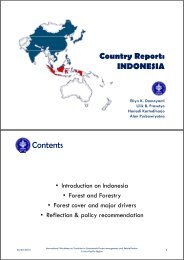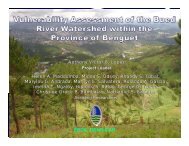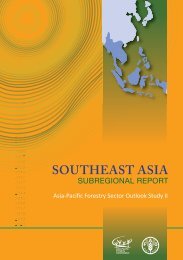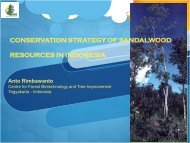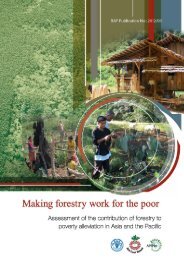Community guidelines for accessing forestry voluntary carbon ... - FAO
Community guidelines for accessing forestry voluntary carbon ... - FAO
Community guidelines for accessing forestry voluntary carbon ... - FAO
You also want an ePaper? Increase the reach of your titles
YUMPU automatically turns print PDFs into web optimized ePapers that Google loves.
<strong>Community</strong> <strong>guidelines</strong> <strong>for</strong> <strong>accessing</strong> <strong>for</strong>estry <strong>voluntary</strong> <strong>carbon</strong> markets<br />
2.2.10 Make the most of <strong>for</strong>est products<br />
Many <strong>for</strong>est products, particularly wood products, last a long time.<br />
Until they are burned or decayed, they continue to store <strong>carbon</strong> and<br />
prevent GHG emissions. Forest managers can contribute to climate<br />
change mitigation by ensuring that, when trees are harvested, as much<br />
of the wood and other materials as possible is used. They can reduce<br />
GHG emissions further by ensuring that the waste products from timber<br />
processing are not burned, but recycled in other processes such as<br />
paper, board or bio-energy.<br />
2.2.11 Improve efficiency in the use of fuelwood<br />
As in <strong>for</strong>est fires, the burning of fuelwood releases stored <strong>carbon</strong> straight<br />
back to the atmosphere. Forest managers can there<strong>for</strong>e contribute to<br />
climate change mitigation by improving the efficiency of fuelwood use.<br />
Open fires, as used by local communities in many developing countries,<br />
are quite inefficient and result in large amounts of waste, contributing<br />
to <strong>for</strong>est degradation and sometimes to de<strong>for</strong>estation, air pollution and<br />
soil erosion. Fuel-efficient cooking stoves reduce the pressure placed on<br />
local <strong>for</strong>ests by reducing the amount of wood consumed by up to 60<br />
percent. They are designed to burn wood much more efficiently than<br />
an open fire, and they can even be fueled by compressed agricultural<br />
residues (e.g. nut shells, straw) or animal dung.<br />
40




